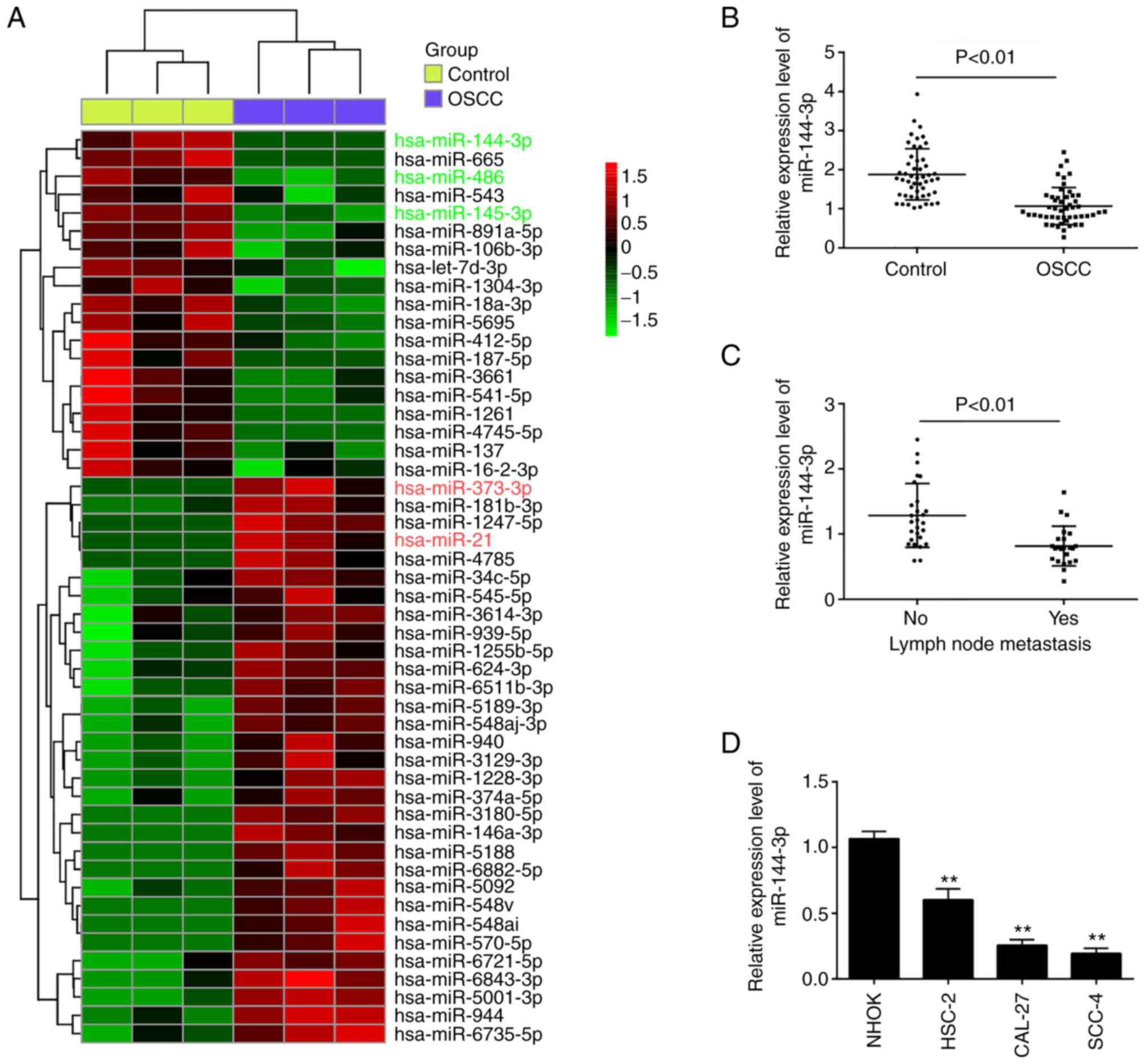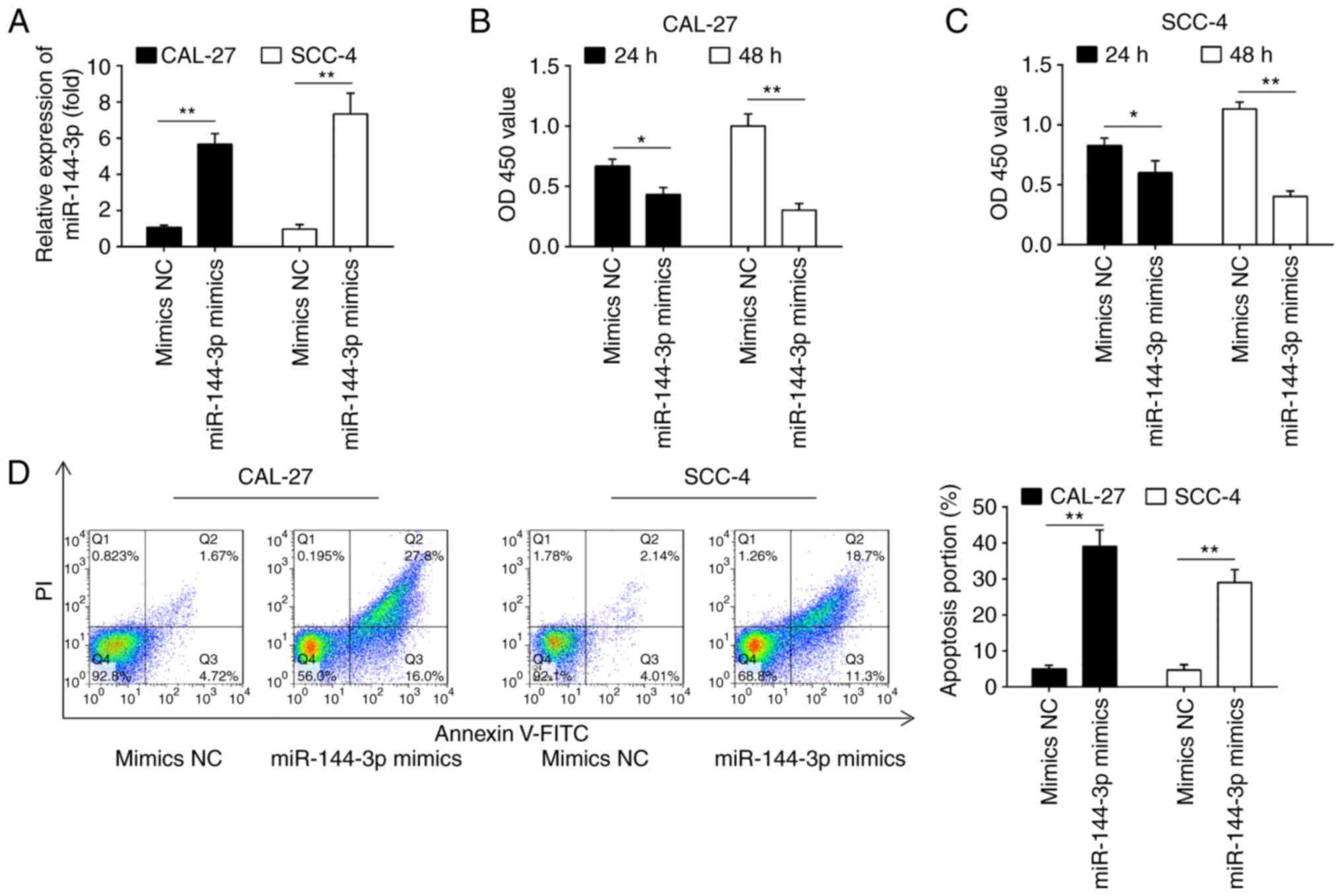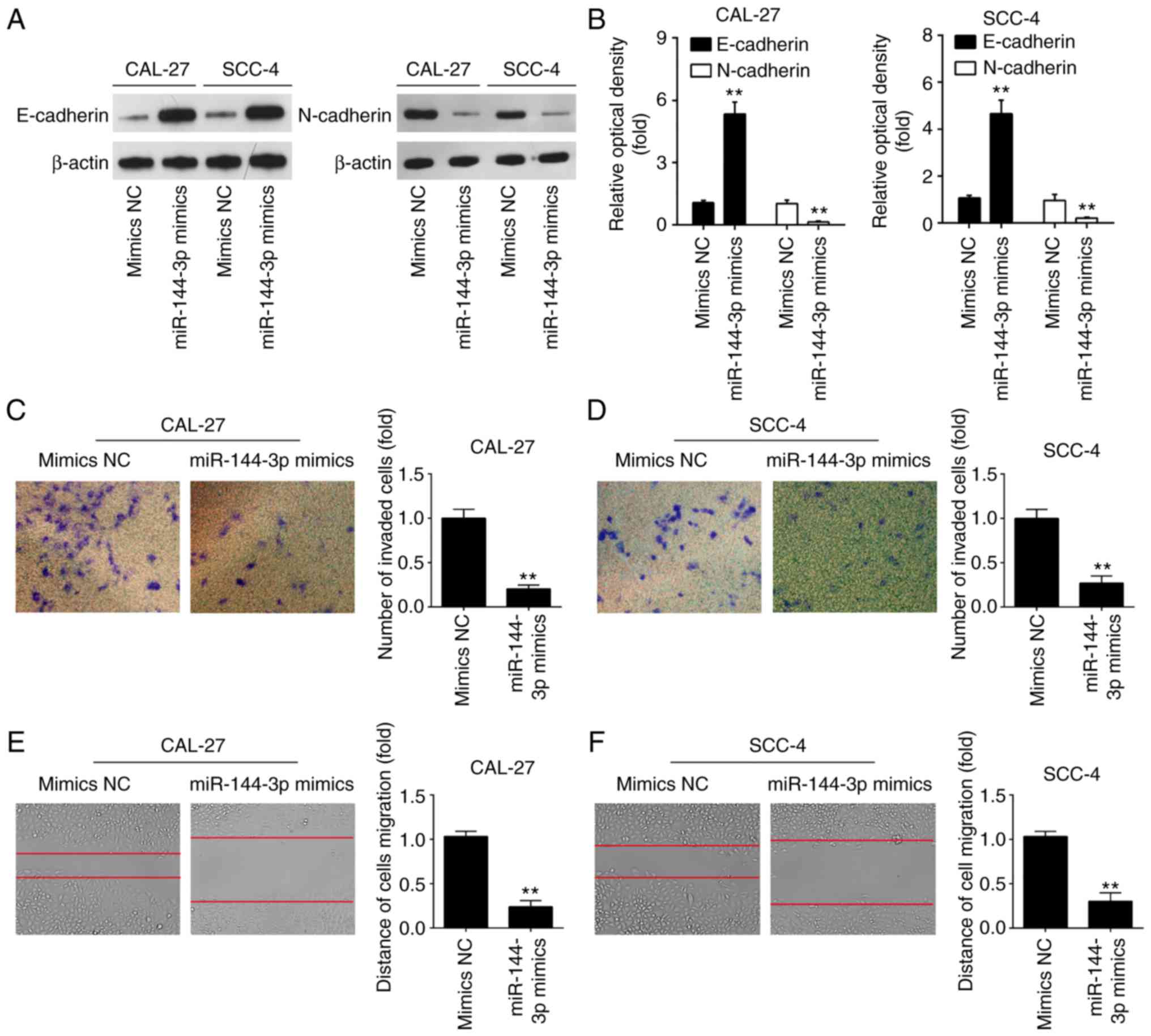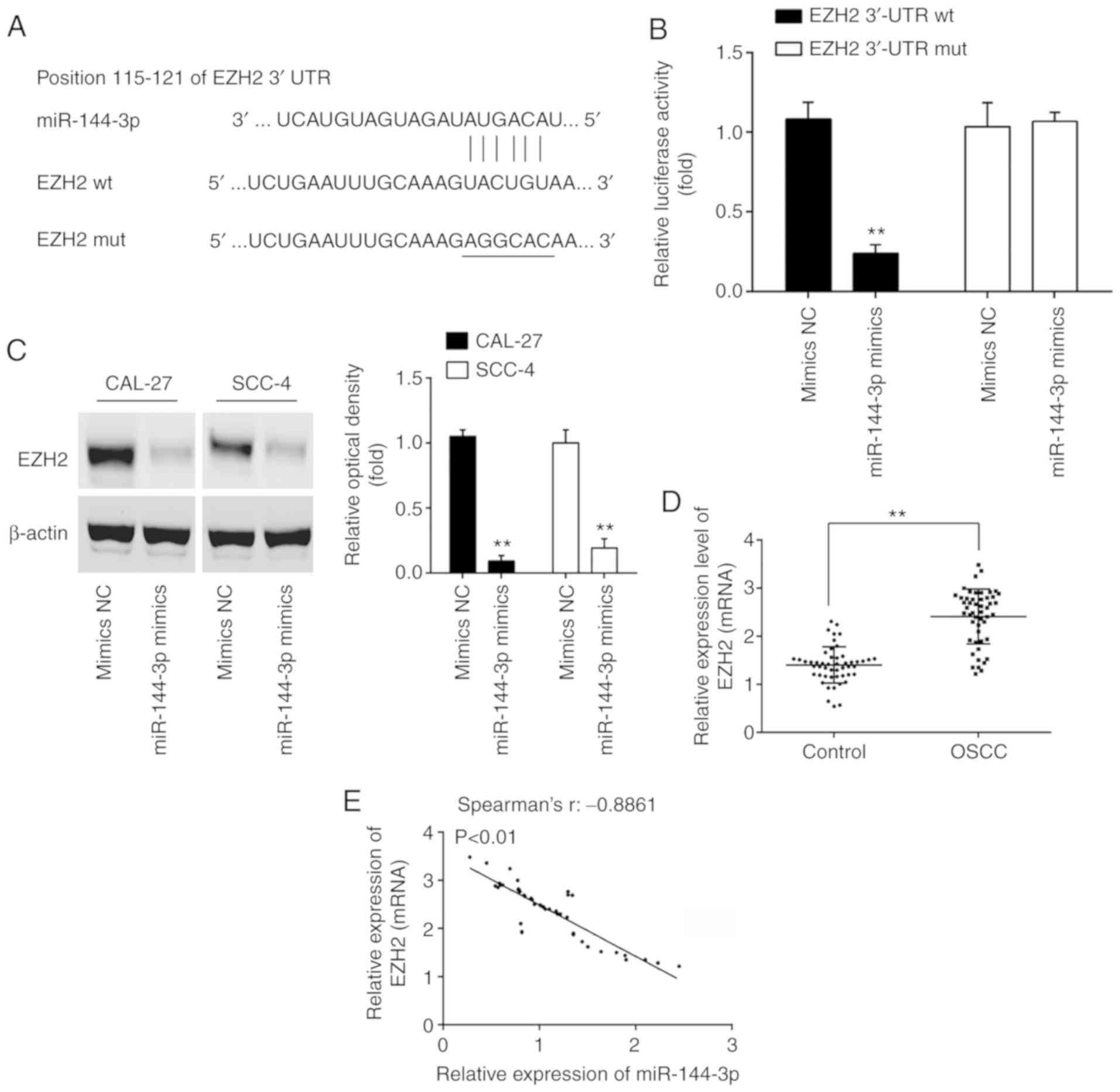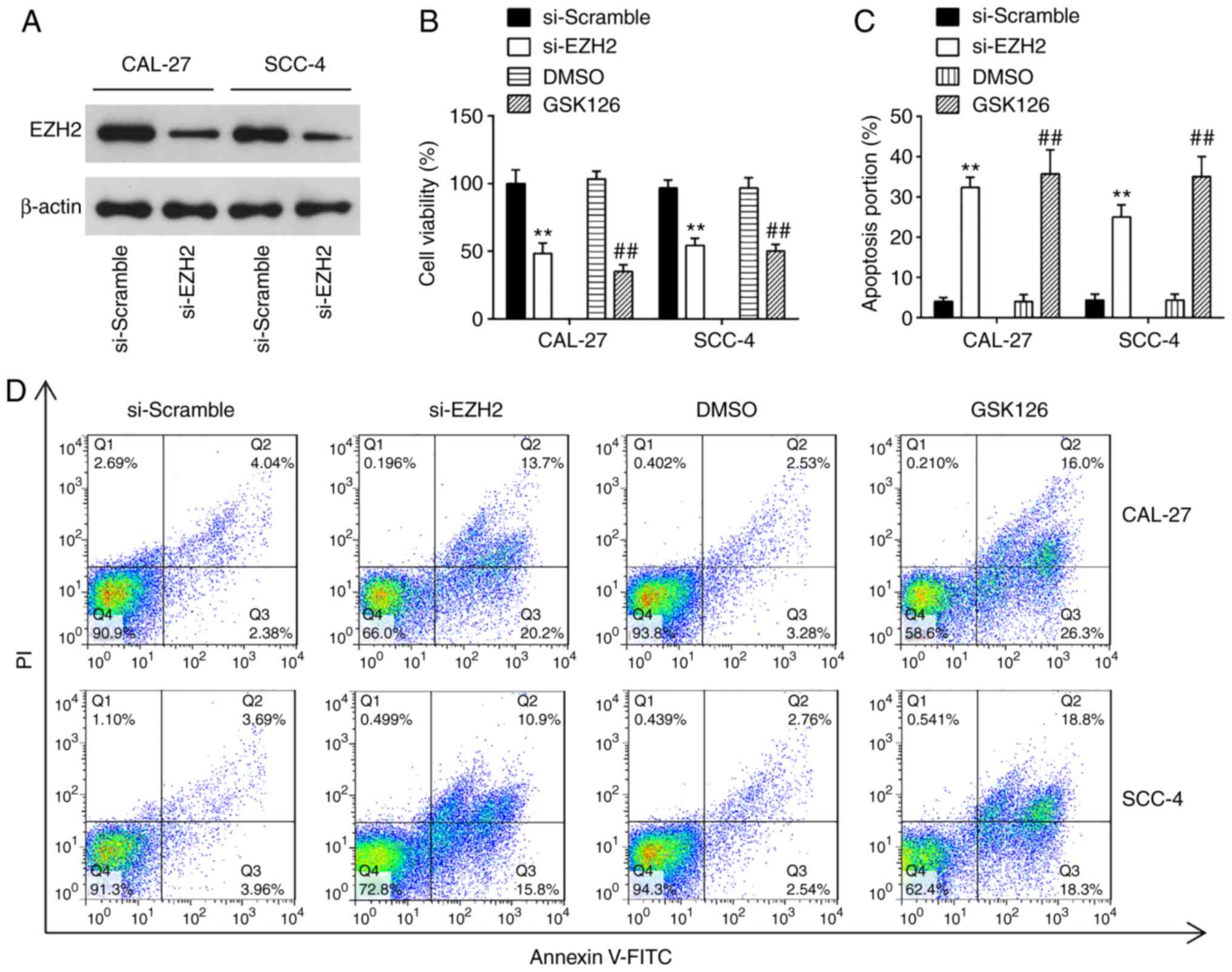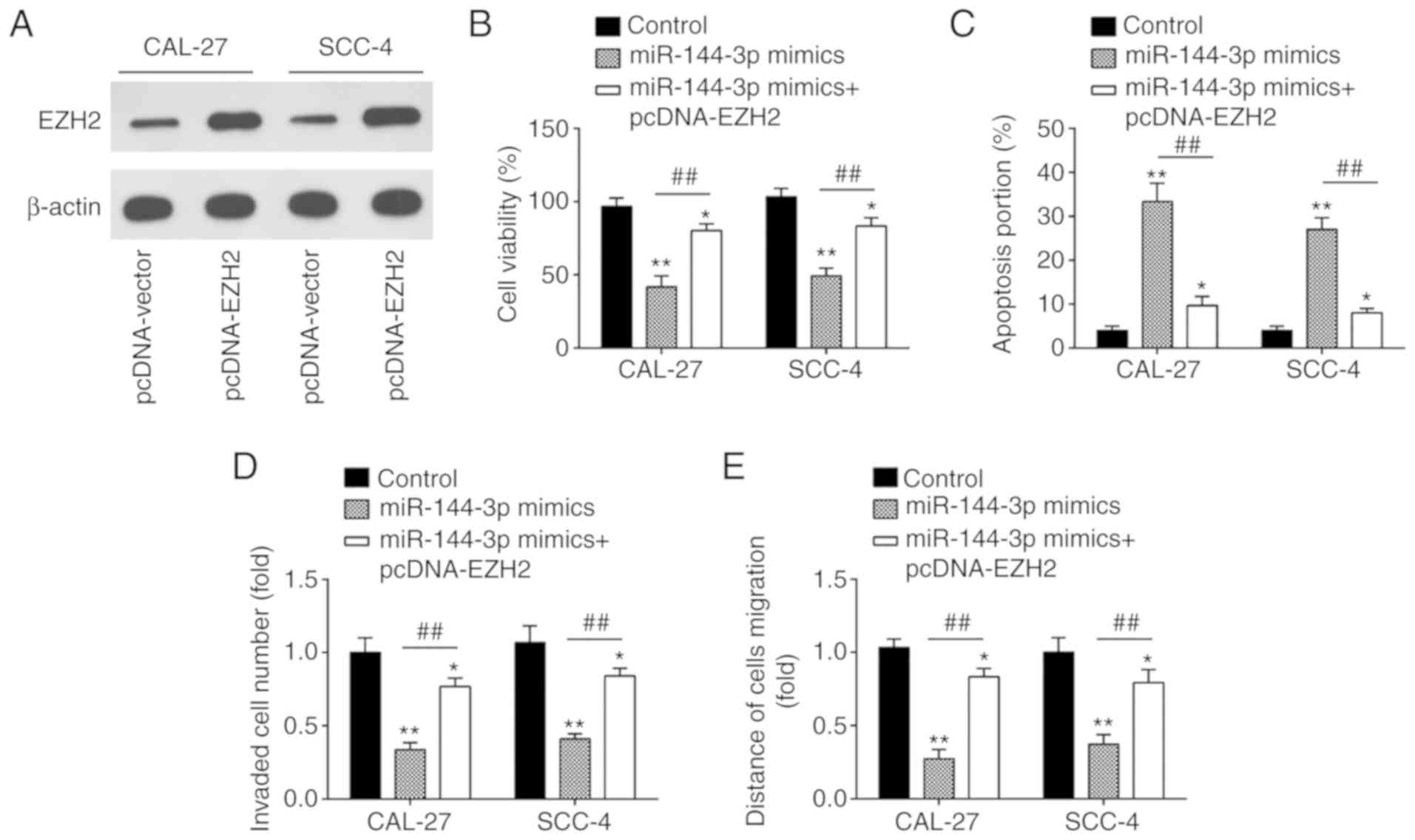|
1
|
Warnakulasuriya S: Global epidemiology of
oral and oropharyngeal cancer. Oral Oncol. 45:309–316. 2009.
View Article : Google Scholar
|
|
2
|
Sasahira T, Kurihara M, Bhawal UK, Ueda N,
Shimomoto T, Yamamoto K, Kirita T and Kuniyasu H: Downregulation of
miR-126 induces angiogenesis and lymphangiogenesis by activation of
VEGF-A in oral cancer. Br J Cancer. 107:700–706. 2012. View Article : Google Scholar : PubMed/NCBI
|
|
3
|
Marsh D, Suchak K, Moutasim KA, Vallath S,
Hopper C, Jerjes W, Upile T, Kalavrezos N, Violette SM, Weinreb PH,
et al: Stromal features are predictive of disease mortality in oral
cancer patients. J Pathol. 223:470–481. 2011. View Article : Google Scholar : PubMed/NCBI
|
|
4
|
Li T and Cho WC: MicroRNAs: Mechanisms,
functions and progress Genomics Proteomics. Bioinformatics.
10:237–238. 2012.
|
|
5
|
Zhang XJ, Jin Y, Song JL and Deng F:
MiR-373 promotes proliferation and metastasis of oral squamous cell
carcinoma by targeting SPOP. Eur Rev Med Pharmacol Sci.
23:5270–5276. 2019.PubMed/NCBI
|
|
6
|
Cui Z, Sun S, Liu Q, Zhou X, Gao S, Peng P
and Li Q: MicroRNA-378-3p/5p suppresses migration and invasion of
oral squamous carcinoma cells by inhibiting KLK4 expression.
Biochem Cell Biol. 98:154–163. 2019. View Article : Google Scholar
|
|
7
|
Zhang C, Hao Y, Sun Y and Liu P: Quercetin
suppresses the tumorigenesis of oral squamous cell carcinoma by
regulating microRNA-22/WNT1/β-catenin axis. J Pharmacol Sci.
140:128–136. 2019. View Article : Google Scholar : PubMed/NCBI
|
|
8
|
Chou ST, Peng HY, Mo KC, Hsu YM, Wu GH,
Hsiao JR, Lin SF, Wang HW and Shiah SG: MicroRNA-486-3p functions
as a tumor suppressor in oral cancer by targeting DDR1. J Exp Clin
Cancer Res. 38:2812019. View Article : Google Scholar : PubMed/NCBI
|
|
9
|
Chen YH, Song Y, Yu YL, Cheng W and Tong
X: miRNA-10a promotes cancer cell proliferation in oral squamous
cell carcinoma by upregulating GLUT1 and promoting glucose
metabolism. Oncol Let. 17:5441–5446. 2019.
|
|
10
|
Peng M and Pang C: MicroRNA-140-5p
inhibits the tumorigenesis of oral squamous cell carcinoma by
targeting p21-activated kinase 4. Cell Biol Int. 2019.Ahead of
print.
|
|
11
|
Parpart S and Wang XW: microRNA regulation
and its consequences in cancer. Curr Pathobiol Rep. 1:71–79. 2013.
View Article : Google Scholar : PubMed/NCBI
|
|
12
|
Shao Y, Qu Y, Dang S, Yao B and Ji M:
MiR-145 inhibits oral squamous cell carcinoma (OSCC) cell growth by
targeting c-Myc and Cdk6. Cancer Cell Int. 13:512013. View Article : Google Scholar : PubMed/NCBI
|
|
13
|
Wei D, Wang W, Shen B, Zhou Y, Yang X, Lu
G, Yang J and Shao Y: MicroRNA199a-5p suppresses migration and
invasion in oral squamous cell carcinoma through inhibiting the
EMTrelated transcription factor SOX4. Int J Mol Med. 44:185–195.
2019.PubMed/NCBI
|
|
14
|
Livak KJ and Schmittgen TD: Analysis of
relative gene expression data using real-time quantitative PCR and
the 2(-Delta Delta C(T)) method. Methods. 25:402–408. 2001.
View Article : Google Scholar
|
|
15
|
Wei D, Shen B, Wang W, Zhou Y, Yang X, Lu
G, Yang J and Shao Y: MicroRNA199a-5p functions as a tumor
suppressor in oral squamous cell carcinoma via targeting the
IKKβ/NF-κB signaling pathway. Int J Mol Med. 43:1585–1596.
2019.PubMed/NCBI
|
|
16
|
Huang S, Wang Z, Zhou J, Huang J, Zhou L,
Luo J, Wan Y, Long H and Zhu B: EZH2 Inhibitor GSK126 suppresses
anti-tumor immunity by driving production of myeloid-derived
suppressor cells. Cancer Res. 79:2009–2020. 2019. View Article : Google Scholar : PubMed/NCBI
|
|
17
|
Yan Y, Wang X, Veno MT, Bakholdt V,
Sørensen JA, Krogdahl A, Sun Z, Gao S and Kjems J: Circulating
miRNAs as biomarkers for oral squamous cell carcinoma recurrence in
operated patients. Oncotarget. 8:8206–8214. 2017. View Article : Google Scholar :
|
|
18
|
Jiang W, Xu Z, Yu L, Che J, Zhang J and
Yang J: MicroRNA-144-3p suppressed TGF-B1-induced lung cancer cell
invasion and adhe-sion by regulating the Src-Akt-Erk pathway. Cell
Biol Int. 2019.Ahead of print.
|
|
19
|
Wu J, Zhao Y, Li F and Qiao B: MiR-144-3p:
A novel tumor suppressor targeting MAPK6 in cervical cancer. J
Physiol Biochem. 75:143–152. 2019. View Article : Google Scholar : PubMed/NCBI
|
|
20
|
Li B, Zhang S, Shen H and Li C:
MicroRNA-144-3p suppresses gastric cancer progression by inhibiting
epithelial-to-mesenchymal transition through targeting PBX3.
Biochem Biophys Res Commun. 484:241–247. 2017. View Article : Google Scholar : PubMed/NCBI
|
|
21
|
Zhao L, Yu Y, Wu J, Bai J, Zhao Y, Li C,
Sun W and Wang X: Role of EZH2 in oral squamous cell carcinoma
carcinogenesis. Gene. 537:197–202. 2014. View Article : Google Scholar : PubMed/NCBI
|
|
22
|
Li Y, Wan Q, Wang W, Mai L, Sha L, Mashrah
M, Lin Z and Pan C: LncRNA ADAMTS9-AS2 promotes tongue squamous
cell carcinoma proliferation, migration and EMT via the
miR-600/EZH2 axis. Biomed Pharmacother. 112:1087192019. View Article : Google Scholar : PubMed/NCBI
|
|
23
|
Labbe DP, Sweeney CJ, Brown M, Galbo P,
Rosario S, Wadosky KM, Ku SY, Sjostrom M, Alshalalfa M, Erho N, et
al: TOP2A and EZH2 provide early detection of an aggressive
prostate cancer subgroup. Clin Cancer Res. 23:7072–7083. 2017.
View Article : Google Scholar : PubMed/NCBI
|
|
24
|
Liu D, Li Y, Luo G, Xiao X, Tao D, Wu X,
Wang M, Huang C, Wang L, Zeng L and Jiang G: LncRNA SPRY4-IT1
sponges miR-101-3p to promote proliferation and metastasis of
bladder cancer cells through up-regulating EZH2. Cancer Lett.
388:281–291. 2017. View Article : Google Scholar
|
|
25
|
Wang Y, Chen Y, Geng H, Qi C, Liu Y and
Yue D: Overexpression of YB1 and EZH2 are associated with cancer
metastasis and poor prognosis in renal cell carcinomas. Tumour
Biol. 36:7159–7166. 2015. View Article : Google Scholar : PubMed/NCBI
|
|
26
|
Wang L and Liu H: microRNA-188 is
downregulated in oral squamous cell carcinoma and inhibits
proliferation and invasion by targeting SIX1. Tumour Biol.
37:4105–4113. 2016. View Article : Google Scholar
|
|
27
|
Ding J, Sun D and Xie P: Elevated
microRNA-145 inhibits the development of oral squamous cell
carcinoma through inactivating ERK/MAPK signaling pathway by
down-regulating HOXA1. Biosci Rep. 39:BSR201822142019. View Article : Google Scholar : PubMed/NCBI
|
|
28
|
Li X, Li Y, Jiang C, Chen L and Gan N:
MicroRNA-144-3p inhibits tumorigenesis of oral squamous cell
carcinoma by downregulating ERO1L. J Cancer. 11:759–768. 2020.
View Article : Google Scholar : PubMed/NCBI
|
|
29
|
Yu M, Lin Y, Zhou Y, Jin H, Hou B, Wu Z,
Li Z, Jian Z and Sun J: MiR-144 suppresses cell proliferation,
migration, and invasion in hepatocellular carcinoma by targeting
SMAD4. Onco Targets Ther. 9:4705–4714. 2016. View Article : Google Scholar : PubMed/NCBI
|
|
30
|
Mushtaq F, Zhang J and Li J: miR-144
suppresses cell proliferation and invasion in gastric cancer
through downregulation of activating enhancer-binding protein 4.
Oncol Lett. 17:5686–5692. 2019.PubMed/NCBI
|
|
31
|
Yamada Y, Arai T, Kojima S, Sugawara H,
Kato M, Okato A, Yamazaki K, Naya Y, Ichikawa T and Seki N:
Regulation of antitumor miR-144-5p targets oncogenes: Direct
regulation of syndecan-3 and its clinical significance. Cancer Sci.
109:2919–2936. 2018. View Article : Google Scholar : PubMed/NCBI
|
|
32
|
Chen N, Feng L, Lu K, Li P, Lv X and Wang
X: STAT6 phosphor-ylation upregulates microRNA-155 expression and
subsequently enhances the pathogenesis of chronic lymphocytic
leukemia. Oncol Lett. 18:95–100. 2019.PubMed/NCBI
|
|
33
|
Pedersen NJ, Jensen DH, Lelkaitis G, Kiss
K, Charabi BW, Ullum H, Specht L, Schmidt AY, Nielsen FC and
Buchwald C: MicroRNA-based classifiers for diagnosis of oral cavity
squamous cell carcinoma in tissue and plasma. Oral Oncol. 83:46–52.
2018. View Article : Google Scholar : PubMed/NCBI
|
|
34
|
Gu W, Zhang E, Song L, Wang Z, Tu L, Tian
F, Aikenmu K, Chu G and Zhao J: Long noncoding RNA HOXD-AS1
aggravates osteosarcoma carcinogenesis through epigenetically
inhibiting p57 via EZH2. Biomed Pharmacother. 106:890–895. 2018.
View Article : Google Scholar : PubMed/NCBI
|
|
35
|
Pasini D, Bracken AP, Hansen JB, Capillo M
and Helin K: The polycomb group protein Suz12 is required for
embryonic stem cell differentiation. Mol Cell Biol. 27:3769–3779.
2007. View Article : Google Scholar : PubMed/NCBI
|
|
36
|
Kondo Y: Targeting histone
methyltransferase EZH2 as cancer treatment. J Biochem. 156:249–257.
2014. View Article : Google Scholar : PubMed/NCBI
|
|
37
|
Matsukawa Y, Semba S, Kato H, Ito A,
Yanagihara K and Yokozaki H: Expression of the enhancer of zeste
homolog 2 is correlated with poor prognosis in human gastric
cancer. Cancer Sci. 97:484–491. 2006. View Article : Google Scholar : PubMed/NCBI
|
|
38
|
Raman JD, Mongan NP, Tickoo SK, Boorjian
SA, Scherr DS and Gudas LJ: Increased expression of the polycomb
group gene, EZH2, in transitional cell carcinoma of the bladder.
Clin Cancer Res. 11:8570–8576. 2005. View Article : Google Scholar : PubMed/NCBI
|
|
39
|
Song-Bing H, Hao Z, Jian Z, Guo-Qiang Z,
Tuo H, Dai-Wei W, Wen G, Lin G, Yi Z, Xiao-Feng X, et al:
Inhibition of EZH2 expression is associated with the proliferation,
apoptosis and migration of SW620 colorectal cancer cells in vitro.
Exp Biol Med. 240:546–555. 2015.
|
|
40
|
Yoo KH and Hennighausen L: EZH2
methyltransferase and H3K27 methylation in breast cancer. Int J
Biol Sci. 8:59–65. 2012. View Article : Google Scholar : PubMed/NCBI
|
|
41
|
Kim KH and Roberts CW: Targeting EZH2 in
cancer. Nat Med. 22:128–134. 2016. View Article : Google Scholar : PubMed/NCBI
|
|
42
|
Kim W, Bird GH, Neff T, Guo G, Kerenyi MA,
Walenssky LD and Orkin SH: Targeted disruption of the EZH2-EED
complex inhibits EZH2-dependent cancer. Nat Chem Biol. 9:643–650.
2013. View Article : Google Scholar : PubMed/NCBI
|
|
43
|
Sun J, Tian X, Lu SQ and Hu HB:
MicroRNA-4465 suppresses tumor proliferation and metastasis in
non-small cell lung cancer by directly targeting the oncogene EZH2.
Biomed Pharmacother. 96:1358–1362. 2017. View Article : Google Scholar : PubMed/NCBI
|
|
44
|
Fan DC, Zhao YR, Qi H, Hou JX and Zhang
TH: MiRNA-506 presents multiple tumor suppressor activities by
targeting EZH2 in nasopharyngeal carcinoma. Auris Nasus Larynx.
2020.Ahead of print. View Article : Google Scholar : PubMed/NCBI
|
|
45
|
Gall Troselj K, Novak Kujundzic R and
Ugarkovic D: Polycomb repressive complex's evolutionary conserved
function: The role of EZH2 status and cellular background. Clin
Epigenetics. 8:552016. View Article : Google Scholar : PubMed/NCBI
|
|
46
|
Zhao K, He J, Wang YF, Jin SD, Fan Y, Fang
N, Qian J, Xu TP and Guo RH: EZH2-mediated epigenetic suppression
of EphB3 inhibits gastric cancer proliferation and metastasis by
affecting E-cadherin and vimentin expression. Gene. 686:118–124.
2019. View Article : Google Scholar
|
|
47
|
Ito T, Teo YV, Evans SA, Neretti N and
Sedivy JM: Regulation of cellular senescence by polycomb chromatin
modifiers through distinct DNA damage- and histone
methylation-dependent path-ways. Cell Rep. 22:3480–3492. 2018.
View Article : Google Scholar : PubMed/NCBI
|
|
48
|
Knutson SK, Warholic NM, Wigle TJ, Klaus
CR, Allain CJ, Raimondia A, Scott MP, Chesworth R, Moyer MP,
Copeland RA, et al: Durable tumor regression in genetically altered
malignant rhab tumors by inhibition of methyltransferase EZH2. Proc
Natl Acad Sci USA. 110:7922–7927. 2013. View Article : Google Scholar
|
|
49
|
Jung HY, Jun S, Lee M, Kim HC, Wang X, Ji
H and Park J II: PAF and EZH2 induce Wnt/β-catenin signaling
hyperactivation. Mol Cell. 52:193–205. 2013. View Article : Google Scholar : PubMed/NCBI
|
|
50
|
Liu Q, Wang G, Li Q, Jiang W, Kim JS, Wang
R, Zhu S, Wang X, Yan L, Yi Y, et al: Polycomb group proteins EZH2
and EED directly regulate androgen receptor in advanced prostate
cancer. Int J Cancer. 145:415–426. 2019. View Article : Google Scholar : PubMed/NCBI
|















